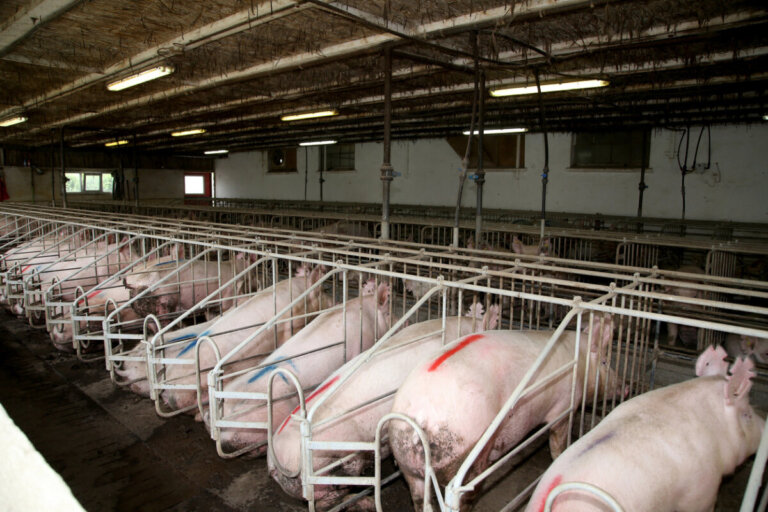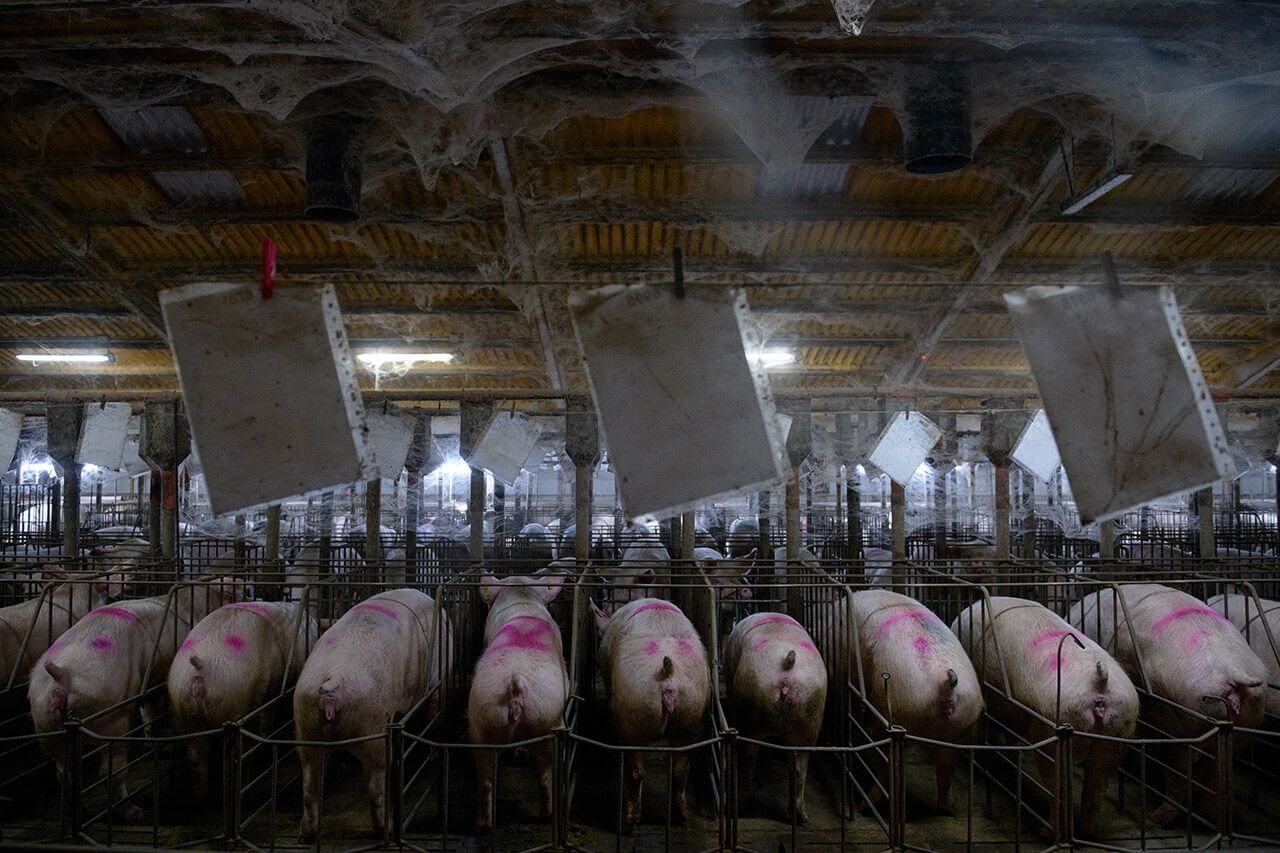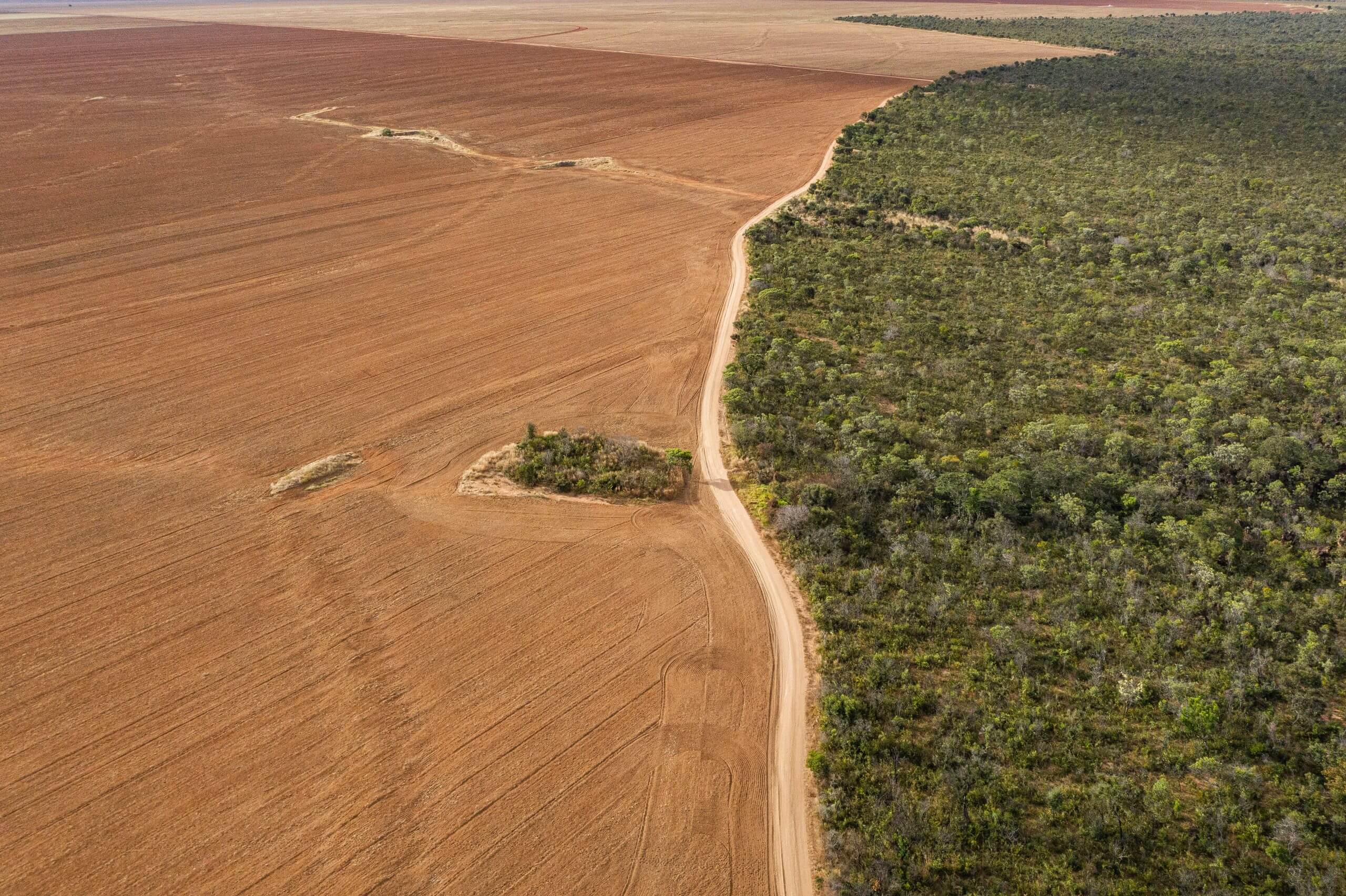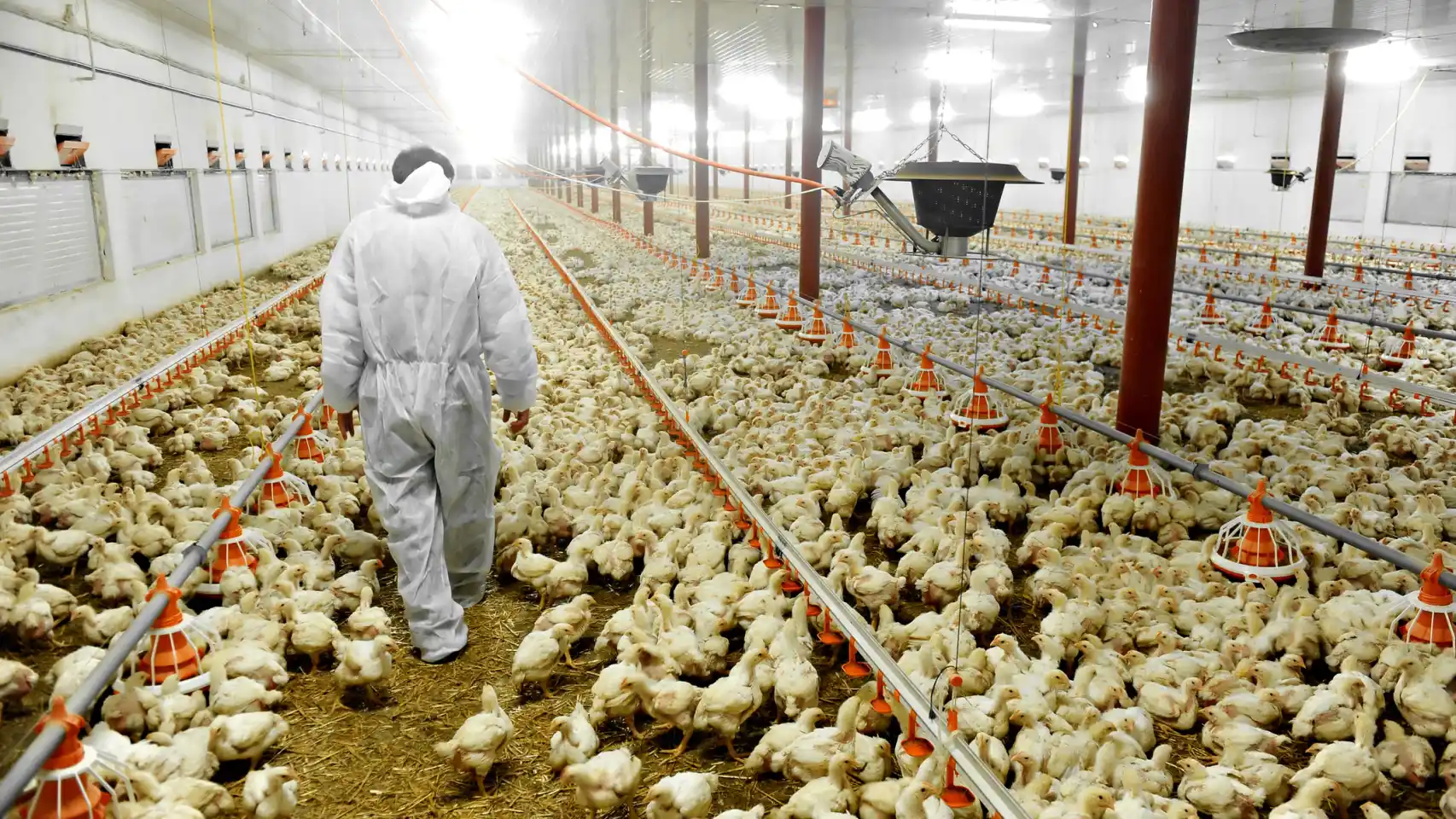Macro Farms: What Are They and How Do They Work?


Written and verified by the veterinarian and zootechnician Sebastian Ramirez Ocampo
According to estimates by the organization Our World in Data, the world produces more than 340 million tons of meat per year. This is 4 times more than what was generated just 5 decades ago. However, to reach these figures, livestock farms have had to evolve toward super-intensive systems such as macro farms, where maximum use is made of available resources.
However, due to the impact of these industrial farms on the environment, health, and animal welfare, whether this is really an ethical and sustainable practice over time has been questioned.
In the following article, we’ll explore how this agricultural model works, what its advantages and disadvantages are, as well as the concerns that arise around these farms and their future prospects.
What are macro farms?
Livestock farms dedicated to meat production can be classified according to animal density, feeding methods, and the conditions in which the species live during their productive cycle. According to these characteristics, it’s possible to differentiate the following livestock farming models:
- Extensive: In this system, animals feed on the natural resources provided by the territory they inhabit. In other words, practices such as grazing prevail over the supply of exogenous sources, such as commercial diets. In addition, the species develop in the open air and the density of individuals per square meter is relatively low.
- Semi-intensive: This is a type of mixed farming where the animals are free during certain hours of the day or times of the year. However, they remain stabled for another period and are subjected to intensive feeding. Diets of vegetable origin, grains, and concentrated feed are combined.
- Intensive: In this case, the animals are kept in special facilities throughout their lives. They’re fed mainly on diets formulated to obtain higher weight gain in less time and at lower cost.
- Super-intensive: As the name suggests, these are intensive systems taken to the next level. In this type of production, the maximum yield of the available resources is sought, and the maximum profitability per kilogram of meat produced is a priority. Animal densities are high and, in many cases, the species are overcrowded.
The latter production model includes macro-farms: Industrial-scale livestock farms with the capacity to produce a large amount of meat in a reduced space.
To be precise, the environmental organization Greenpeace describes them as farms with more than 40,000 places for poultry and more than 2,000 places for pigs weighing more than 65 pounds.
However, these numbers are far exceeded. According to an article in The Conversation, the numbers can run into the tens of thousands for pigs and into the millions for broiler chickens.

How do macro farms work?
Macro farms are a type of livestock farming that doesn’t have land. Instead, they have automated and technified facilities that allow thousands of animals to be housed in a limited area.
The species remain housed inside the farms and, in most cases, don’t have access to the outside at any time during their lives.
In addition, they require many external inputs such as water and concentrated feed, because in order to achieve the desired production levels, feed intake must be constant. Thanks to this, a meat product is obtained in less time and at a lower production cost.
According to the latest Meat Atlas report published in 2021, Spain has gone from producing one million tons of meat in the 1970s to more than 7 million tons today. This has made it one of the main producers and exporters of this input within the European Union, surpassing countries such as France and Italy.
In part, these numbers have been achieved thanks to the expansion of macro farms in this territory, which, according to data from the Spanish Ministry of Agriculture, have increased by 6 % over the last year in the case of pigs.
However, producing this amount of meat at a low cost has its impacts both on the quality of life and animal welfare and on the environment in which the farms are located.

What’s the problem with macro farms?
There are several negative aspects associated with macro farms around the world. The following are the main problems derived from meat production at industrial levels.
Slurry
Slurry is all the organic waste generated during animal fattening. Examples include:
- Wastewater
- Feed residues
- Solid and liquid excrement
According to a study reported by the newspaper El País, in Spain alone, macro-farms produce more than 2 billion cubic meters of slurry per year.
This is enough to cover the center of Madrid, fill 62 soccer stadiums such as the Santiago Bernabeu, or occupy 24,800 Olympic swimming pools.
Although farms must submit a slurry management protocol to the government, in many cases, it’s not complied with. As a result, the environment and natural resources are heavily polluted, according to the authors of the article cited above.
On the one hand, although ideally, this waste should be transported to other farms to be used as organic fertilizer, the transfer is costly. Therefore, farms opt to dump the slurry in nearby sites that aren’t suitable for this purpose. This results in saturation and contamination of the soil and aquifers near the area.
In addition, macro farms must have ponds or places to store the slurry prior to transfer. However, as reported in a document from the Spanish Ministry for Ecological Transition and the Demographic Challenge, some of these ponds aren’t adequately constructed.
As a result, the waste leaches into the ground and contaminates the water of nearby wells and reservoirs.
According to estimates from the same ministry, 22% of surface water and 23% of groundwater in Spain are contaminated by nitrates present in slurry.
Emission of greenhouse gases and air pollution
In essence, greenhouse gases are those compounds that agglomerate in the atmosphere and absorb infrared energy from the sun. They’re considered to be one of the main triggers of the climate change that we’re experiencing today.
One of them is methane, gas produced during the digestion of food in animals.
According to an article in the Revista Colombiana de Ciencias Pecuarias, methane contributes to approximately 18% of the global warming currently occurring.
At the same time, according to a report by the Spanish media Datadista, published in the portal El Diario in the year 2020, methane emissions from large-scale farms in Spain will amount to about 96,000 tons, a figure that’s not at all encouraging.
However, air pollution doesn’t stop there, as the degradation of slurry generates another toxic gas known as ammonia. This element, in large proportions, is associated with respiratory and eye problems in humans. It also contributes to the degradation of water resources and soil.
As stated by the Greenpeace organization, industrial farms were responsible for 94 % of the ammonia emissions declared in 2020 throughout Spain. Of these, 69 % corresponded to pig farms and 25 % to poultry farming. No data is available on vaccine production, as they’re not obliged to report their emissions.
Deforestation
As mentioned in previous lines, macro farms need a lot of concentrated feed to reach their production standards. These commercial diets are formulated based on some ingredients such as soybean, a very good performing source of vegetable protein.
However, this legume is hardly grown in Spain. Instead, it’s imported, at a lower cost, from South American countries:
- Argentina
- Brazil
- Colombia
- Bolivia
However, as the report Con la soja al cuello, the production of soybean in these regions is associated with deforestation and the detriment of biodiversity, as large areas of natural forests and jungles are cut down for its planting.
They even state that the European Union is the world’s second largest importer of environmental destruction. It’s also responsible for 16% of deforestation linked to international trade.
Among other things, according to the FAO, 13 billion hectares of forest area are lost every year due to the conversion of land for the production of food or fodder crops. They also estimate that 33% of arable land is used for the production of legumes to feed livestock.
Finally, the authors of the above-mentioned report share a disturbing fact: Of the nearly 400 million tons of soybean produced in the world, only 6% is used for human consumption.
In essence, soybean cultivation is only a mainstay of large-scale meat production on the planet.

Animal welfare
Without exaggerating, the reality is that macro-farms are true mass-production meat factories. In order to obtain a higher yield, animals are confined and housed only to eat and fatten up.
This type of production system violates some of the fundamental rights of animals – proclaimed by organizations such as the United Nations (UN) and UNESCO – such as the right to enjoy mobility and free development under species-specific conditions.
In addition, as explained in a publication of the Journal of Agricultural and Environmental Ethics, the animals on these farms show the following symptoms:
- Fear
- Anguish
- Emotional and physical stress
- Behavioral disorders – in some cases – as they’re unable to see sunlight in their entire lives
In clear terms, macro farms sacrifice animal welfare in exchange for higher production rates:
- Lower cost
- Less time
- Under complete human control
If one were to compare it to a car assembly plant, the only difference is that macro farms deal with living beings.
What are the advantages and disadvantages of a model such as macro-farms?
To be more exact and provide a clear picture of industrial production farms, it’s possible to synthesize the information in positive and negative aspects as follows:
Advantages
- Meat supply to a growing population
- More optimal adaptation to the economic variables determined by the market
- Greater meat production at a lower cost
- Decrease in the space required to produce one kilogram of meat in relation to extensive production
- Increased control, technification, and standardization
- The generation of employment
- Cheaper sale of meat to the public
- The source of income for the country’s economy
Disadvantages
- Serious contamination of the soil, water, and air of the environment in which they work
- High water and energy consumption to produce one kilogram of meat
- Negative impact on biodiversity and natural resources in developing countries
- An active influence on climate change and global warming
- The meat produced has a worse nutritional profile than that of animals raised in other systems
- Production of irreversible damage to the environment, making them unsustainable in the long term
- Animal exploitation at inhumane levels
- As they grow, smaller productions are ruined by their inability to compete
- Overcrowding and risk of disease transmission
- Reification of animal life
- Heavily medicated animals, resulting in a risk of antibiotic resistance
How many macro farms are there in Spain?
According to data from the State Register of Emissions and Pollutant Sources (PRTR), in Spain, there are some 3,887 macro-farms for the intensive breeding and fattening of pigs and poultry. They’re located in 1,372 municipalities in the country, with a greater presence in the following autonomous communities:
- Aragón
- Catalonia
- Castilla y León
It’s worth noting that industrial farms are located in areas where the population is smaller or far from major cities. For example, there are no macro farms near places like Malaga or Madrid, while there is a high density in the north of Catalonia.

An uncomfortable reality
The aim of this article isn’t to demonize and much less condemn the consumption of animal meat, but to raise awareness of the main problems associated with industrial-scale production.
However, it’s important to raise awareness about consumption habits and the way in which natural resources are used to produce food.
As has been explained throughout this article, this type of model is unsustainable in the future. Therefore, the human race must aim for other systems that are environmentally friendly and respect dignity, as well as animal welfare throughout the process.
Some countries such as Holland, Germany, and Spain itself have already taken measures to control the expansion of macro-farms in their territories. For example, the country of Spain has issued a new decree limiting the number of cows that an intensive farm can have. Now, it’s only possible to have 725 dairy cows and 850 head of cattle.
It’ll be necessary to continue with this type of policies and efforts to achieve food security, but without paying the high cost of destroying the place where we all live.
According to estimates by the organization Our World in Data, the world produces more than 340 million tons of meat per year. This is 4 times more than what was generated just 5 decades ago. However, to reach these figures, livestock farms have had to evolve toward super-intensive systems such as macro farms, where maximum use is made of available resources.
However, due to the impact of these industrial farms on the environment, health, and animal welfare, whether this is really an ethical and sustainable practice over time has been questioned.
In the following article, we’ll explore how this agricultural model works, what its advantages and disadvantages are, as well as the concerns that arise around these farms and their future prospects.
What are macro farms?
Livestock farms dedicated to meat production can be classified according to animal density, feeding methods, and the conditions in which the species live during their productive cycle. According to these characteristics, it’s possible to differentiate the following livestock farming models:
- Extensive: In this system, animals feed on the natural resources provided by the territory they inhabit. In other words, practices such as grazing prevail over the supply of exogenous sources, such as commercial diets. In addition, the species develop in the open air and the density of individuals per square meter is relatively low.
- Semi-intensive: This is a type of mixed farming where the animals are free during certain hours of the day or times of the year. However, they remain stabled for another period and are subjected to intensive feeding. Diets of vegetable origin, grains, and concentrated feed are combined.
- Intensive: In this case, the animals are kept in special facilities throughout their lives. They’re fed mainly on diets formulated to obtain higher weight gain in less time and at lower cost.
- Super-intensive: As the name suggests, these are intensive systems taken to the next level. In this type of production, the maximum yield of the available resources is sought, and the maximum profitability per kilogram of meat produced is a priority. Animal densities are high and, in many cases, the species are overcrowded.
The latter production model includes macro-farms: Industrial-scale livestock farms with the capacity to produce a large amount of meat in a reduced space.
To be precise, the environmental organization Greenpeace describes them as farms with more than 40,000 places for poultry and more than 2,000 places for pigs weighing more than 65 pounds.
However, these numbers are far exceeded. According to an article in The Conversation, the numbers can run into the tens of thousands for pigs and into the millions for broiler chickens.

How do macro farms work?
Macro farms are a type of livestock farming that doesn’t have land. Instead, they have automated and technified facilities that allow thousands of animals to be housed in a limited area.
The species remain housed inside the farms and, in most cases, don’t have access to the outside at any time during their lives.
In addition, they require many external inputs such as water and concentrated feed, because in order to achieve the desired production levels, feed intake must be constant. Thanks to this, a meat product is obtained in less time and at a lower production cost.
According to the latest Meat Atlas report published in 2021, Spain has gone from producing one million tons of meat in the 1970s to more than 7 million tons today. This has made it one of the main producers and exporters of this input within the European Union, surpassing countries such as France and Italy.
In part, these numbers have been achieved thanks to the expansion of macro farms in this territory, which, according to data from the Spanish Ministry of Agriculture, have increased by 6 % over the last year in the case of pigs.
However, producing this amount of meat at a low cost has its impacts both on the quality of life and animal welfare and on the environment in which the farms are located.

What’s the problem with macro farms?
There are several negative aspects associated with macro farms around the world. The following are the main problems derived from meat production at industrial levels.
Slurry
Slurry is all the organic waste generated during animal fattening. Examples include:
- Wastewater
- Feed residues
- Solid and liquid excrement
According to a study reported by the newspaper El País, in Spain alone, macro-farms produce more than 2 billion cubic meters of slurry per year.
This is enough to cover the center of Madrid, fill 62 soccer stadiums such as the Santiago Bernabeu, or occupy 24,800 Olympic swimming pools.
Although farms must submit a slurry management protocol to the government, in many cases, it’s not complied with. As a result, the environment and natural resources are heavily polluted, according to the authors of the article cited above.
On the one hand, although ideally, this waste should be transported to other farms to be used as organic fertilizer, the transfer is costly. Therefore, farms opt to dump the slurry in nearby sites that aren’t suitable for this purpose. This results in saturation and contamination of the soil and aquifers near the area.
In addition, macro farms must have ponds or places to store the slurry prior to transfer. However, as reported in a document from the Spanish Ministry for Ecological Transition and the Demographic Challenge, some of these ponds aren’t adequately constructed.
As a result, the waste leaches into the ground and contaminates the water of nearby wells and reservoirs.
According to estimates from the same ministry, 22% of surface water and 23% of groundwater in Spain are contaminated by nitrates present in slurry.
Emission of greenhouse gases and air pollution
In essence, greenhouse gases are those compounds that agglomerate in the atmosphere and absorb infrared energy from the sun. They’re considered to be one of the main triggers of the climate change that we’re experiencing today.
One of them is methane, gas produced during the digestion of food in animals.
According to an article in the Revista Colombiana de Ciencias Pecuarias, methane contributes to approximately 18% of the global warming currently occurring.
At the same time, according to a report by the Spanish media Datadista, published in the portal El Diario in the year 2020, methane emissions from large-scale farms in Spain will amount to about 96,000 tons, a figure that’s not at all encouraging.
However, air pollution doesn’t stop there, as the degradation of slurry generates another toxic gas known as ammonia. This element, in large proportions, is associated with respiratory and eye problems in humans. It also contributes to the degradation of water resources and soil.
As stated by the Greenpeace organization, industrial farms were responsible for 94 % of the ammonia emissions declared in 2020 throughout Spain. Of these, 69 % corresponded to pig farms and 25 % to poultry farming. No data is available on vaccine production, as they’re not obliged to report their emissions.
Deforestation
As mentioned in previous lines, macro farms need a lot of concentrated feed to reach their production standards. These commercial diets are formulated based on some ingredients such as soybean, a very good performing source of vegetable protein.
However, this legume is hardly grown in Spain. Instead, it’s imported, at a lower cost, from South American countries:
- Argentina
- Brazil
- Colombia
- Bolivia
However, as the report Con la soja al cuello, the production of soybean in these regions is associated with deforestation and the detriment of biodiversity, as large areas of natural forests and jungles are cut down for its planting.
They even state that the European Union is the world’s second largest importer of environmental destruction. It’s also responsible for 16% of deforestation linked to international trade.
Among other things, according to the FAO, 13 billion hectares of forest area are lost every year due to the conversion of land for the production of food or fodder crops. They also estimate that 33% of arable land is used for the production of legumes to feed livestock.
Finally, the authors of the above-mentioned report share a disturbing fact: Of the nearly 400 million tons of soybean produced in the world, only 6% is used for human consumption.
In essence, soybean cultivation is only a mainstay of large-scale meat production on the planet.

Animal welfare
Without exaggerating, the reality is that macro-farms are true mass-production meat factories. In order to obtain a higher yield, animals are confined and housed only to eat and fatten up.
This type of production system violates some of the fundamental rights of animals – proclaimed by organizations such as the United Nations (UN) and UNESCO – such as the right to enjoy mobility and free development under species-specific conditions.
In addition, as explained in a publication of the Journal of Agricultural and Environmental Ethics, the animals on these farms show the following symptoms:
- Fear
- Anguish
- Emotional and physical stress
- Behavioral disorders – in some cases – as they’re unable to see sunlight in their entire lives
In clear terms, macro farms sacrifice animal welfare in exchange for higher production rates:
- Lower cost
- Less time
- Under complete human control
If one were to compare it to a car assembly plant, the only difference is that macro farms deal with living beings.
What are the advantages and disadvantages of a model such as macro-farms?
To be more exact and provide a clear picture of industrial production farms, it’s possible to synthesize the information in positive and negative aspects as follows:
Advantages
- Meat supply to a growing population
- More optimal adaptation to the economic variables determined by the market
- Greater meat production at a lower cost
- Decrease in the space required to produce one kilogram of meat in relation to extensive production
- Increased control, technification, and standardization
- The generation of employment
- Cheaper sale of meat to the public
- The source of income for the country’s economy
Disadvantages
- Serious contamination of the soil, water, and air of the environment in which they work
- High water and energy consumption to produce one kilogram of meat
- Negative impact on biodiversity and natural resources in developing countries
- An active influence on climate change and global warming
- The meat produced has a worse nutritional profile than that of animals raised in other systems
- Production of irreversible damage to the environment, making them unsustainable in the long term
- Animal exploitation at inhumane levels
- As they grow, smaller productions are ruined by their inability to compete
- Overcrowding and risk of disease transmission
- Reification of animal life
- Heavily medicated animals, resulting in a risk of antibiotic resistance
How many macro farms are there in Spain?
According to data from the State Register of Emissions and Pollutant Sources (PRTR), in Spain, there are some 3,887 macro-farms for the intensive breeding and fattening of pigs and poultry. They’re located in 1,372 municipalities in the country, with a greater presence in the following autonomous communities:
- Aragón
- Catalonia
- Castilla y León
It’s worth noting that industrial farms are located in areas where the population is smaller or far from major cities. For example, there are no macro farms near places like Malaga or Madrid, while there is a high density in the north of Catalonia.

An uncomfortable reality
The aim of this article isn’t to demonize and much less condemn the consumption of animal meat, but to raise awareness of the main problems associated with industrial-scale production.
However, it’s important to raise awareness about consumption habits and the way in which natural resources are used to produce food.
As has been explained throughout this article, this type of model is unsustainable in the future. Therefore, the human race must aim for other systems that are environmentally friendly and respect dignity, as well as animal welfare throughout the process.
Some countries such as Holland, Germany, and Spain itself have already taken measures to control the expansion of macro-farms in their territories. For example, the country of Spain has issued a new decree limiting the number of cows that an intensive farm can have. Now, it’s only possible to have 725 dairy cows and 850 head of cattle.
It’ll be necessary to continue with this type of policies and efforts to achieve food security, but without paying the high cost of destroying the place where we all live.
All cited sources were thoroughly reviewed by our team to ensure their quality, reliability, currency, and validity. The bibliography of this article was considered reliable and of academic or scientific accuracy.
- Carmona, J, C., Bolivar, D, M., & Giraldo, L, A. (2005). El gas metano en la producción ganadera y alternativas para medir sus emisiones y aminorar su impacto a nivel ambiental y productivo. Revista Colombiana de Ciencias Pecuarias, 18 (1), 49-63. http://www.scielo.org.co/scielo.php?pid=S0120-06902005000100006&script=sci_abstract&tlng=es
- Delgado, A. & Tudela, A. (2021, 30 de octubre). La fábrica industrial de cerdos. El Diario. https://especiales.eldiario.es/pac-medio-ambiente-espana/macrogranjas/
- Ecologistas en Acción. (2022, 18 de enero). [Informe] Con la soja al cuello: piensos y ganadería industrial en España. https://www.ecologistasenaccion.org/182789/
- Fonseca, R, P. (2022). The Impacts of Animal Farming: A Critical Overview of Primary School Textbooks. Journal of Agricultural and Enviromental Ethics, 35 (12). https://link.springer.com/article/10.1007/s10806-022-09887-2
- Gobierno de España. (2022, 29 de diciembre). Real Decreto 1053/2022, de 27 de diciembre, por el que se establecen normas básicas de ordenación de las granjas bovinas. «BOE» núm. 312. https://www.boe.es/buscar/doc.php?id=BOE-A-2022-23053
- Greenpeace España. (s. f.). Macrogranjas. Consultado el 13 de julio de 2023. https://es.greenpeace.org/es/trabajamos-en/agricultura/macrogranjas/
- Heinrich Böll Stiftung. (2021). Meat Atlas. https://eu.boell.org/en/MeatAtlas
- Liga Internacional de los Derechos de los Animales. (1978, 15 de octubre.). Proclamación de la Declaración Universal de los Derechos de los Animales. https://www.gob.mx/conanp/articulos/proclamacion-de-la-declaracion-universal-de-los-derechos-de-los-animales-223028
- Manzano, P. & Prado, A. (2022, 12 de enero). ¿Podemos renunciar a la ganadería industrial? The Conversation. https://theconversation.com/podemos-renunciar-a-la-ganaderia-industrial-174677
- Ministerio para la Transición Ecológica y el Reto Demográfico de España. (2023). Registro Estatal de Emisiones y Fuentes Contaminantes (PRTR). https://prtr-es.es/Informes/InventarioInstalacionesIPPC.aspx
- Ministerio de Agricultura, Pesca y Alimentación de España. (2022). Indicadores trimestrales de porcinos- octubre de 2022. https://www.mapa.gob.es/es/ganaderia/temas/produccion-y-mercados-ganaderos/sectores-ganaderos/porcino/indicadoreseconomicos.aspx
- Ministerio para la Transición Ecológica y el Reto Demográfico de España. (2022). El Gobierno aprueba un Real Decreto para reducir la contaminación por nitratos y reforzar la protección de las masas de agua más vulnerables. https://www.miteco.gob.es/es/prensa/ultimas-noticias/el-gobierno-aprueba-un-real-decreto-para-reducir-la-contaminaci%C3%B3n-por-nitratos-y-reforzar-la-protecci%C3%B3n-de-las-masas-de-agua-m%C3%A1s-vulnerables/tcm:30-535231
- Ministerio para la Transición Ecológica y el Reto Demográfico de España. (2019). Análisis de soluciones para el vertido cero al Mar Menor proveniente del Campo de Cartagena. https://www.miteco.gob.es/es/agua/temas/concesiones-y-autorizaciones/Mar-Menor-Campo-de-Cartagena-Vertido-Cero.aspx
- Miranda, D. (2022, 15 de enero). Qué es una macrogranja y cómo impacta en el medio ambiente. National Geographic España. Consultado el 13 de julio de 2023. https://www.nationalgeographic.com.es/naturaleza/que-es-macrogranja-y-como-impacta-medioambiente_17760
- Organización de las Naciones Unidas para la Alimentación y la Agricultura (FAO). (2013). El ganado y los paisajes. https://www.fao.org/publications/card/fr/c/15b5ec3f-142a-5ef4-97c4-026776536fa3/
- Our World in Data. (2017). Meat and Dairy Production. https://ourworldindata.org/meat-production
- Padappayil, R. P., & Borger, J. (2023). Ammonia Toxicity. StatPearls Publishing. https://www.ncbi.nlm.nih.gov/books/NBK546677/
- Statista. (2023). Ranking de los principales países productores de soja a nivel mundial en 2021. Consultado el 13 de julio de 2023. https://es.statista.com/estadisticas/600145/paises-lideres-en-produccion-de-soja-a-nivel-mundial/
- Zafra, M., Medina, M., Grasso, D., Vicente, J., Pires, L. (2022, 23 de enero). Las macrogranjas, paso a paso: un proceso industrial para criar 53 millones de cerdos al año. El País. https://elpais.com/clima-y-medio-ambiente/2022-01-23/las-macrogranjas-paso-a-paso-un-proceso-industrial-para-criar-53-millones-de-cerdos-al-ano.html
This text is provided for informational purposes only and does not replace consultation with a professional. If in doubt, consult your specialist.








